FOUR STROKE COMBUSTION ENGINE
FOUR STROKE COMBUSTION ENGINE
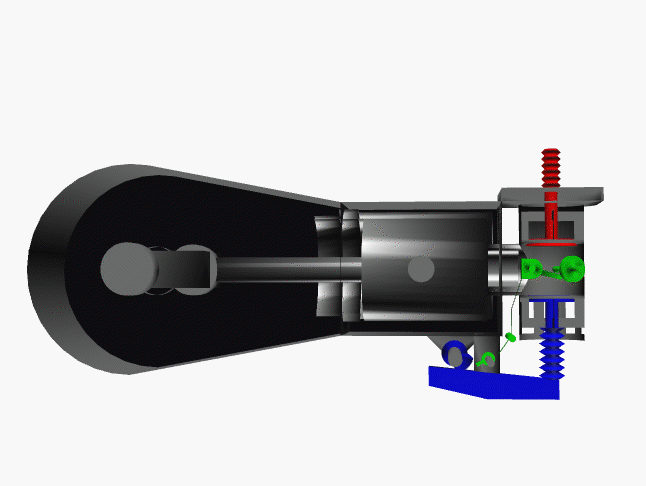
This is an animated computer drawing of one cylinder of the Wright brothers'
1903 aircraft engine. This engine powered the first, heavier than air,
self-propelled, maneuverable, piloted aircraft; the Wright 1903 Flyer. The
engine consisted of four cylinders like the one
shown above, with each piston connected to a common crankshaft. The crankshaft was connected to two
counter-rotating propellers which produced the thrust necessary to overcome the drag of the aircraft.
The brothers' design is very simple by today's standards, so it is a good
engine for students to study to learn the fundamentals of engine operation. This
type of internal combustion engine is called a
four-stroke engine because there are four movements, or strokes, of the piston before the entire engine firing
sequence is repeated. The four strokes are described below with some still
figures. In the animation and in all the figures, we have colored the fuel/air intake system red, the electrical system green, and the exhaust system blue. We also represent the fuel/air
mixture and the exhaust gases by small colored balls to show how these gases
move through the engine. Since we will be referring to the movement of various
engine parts, here is a figure showing the names of the parts:
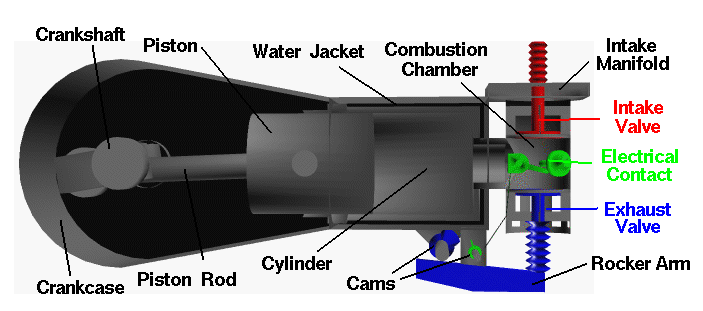
Intake Stroke
The engine cycle begins with the intake stroke as the piston is pulled towards the
crankshaft (to the left in the figure).
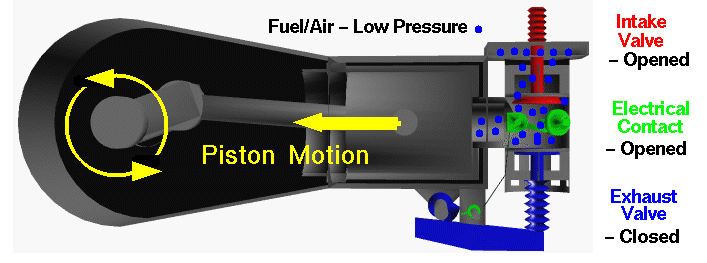
The intake valve is open, and fuel and air are drawn past the valve and into
the combustion chamber and cylinder from the intake manifold located on top of
the combustion chamber. The exhaust valve is closed and the electrical contact
switch is open. The fuel/air mixture is at a relatively low pressure (near atmospheric) and is colored blue in this
figure. At the end of the intake stroke, the piston is located at the far left
and begins to move back towards the right.
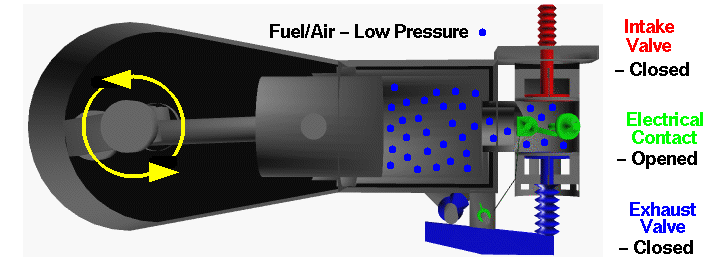
The cylinder and combustion chamber are full of the low pressure fuel/air
mixture and, as the piston begins to move to the right, the intake valve closes.
Historical note - The opening and closing of the intake valve of
the Wright 1903 engine was termed "automatic" by the brothers. It relies on the
slightly lower pressure within in the cylinder during the intake stroke to
overcome the strength of the spring holding the valve shut. Modern internal
combustion engines do not work this way, but use cams and rocker arms like the
brothers' exhaust system. Cams and rocker arms provide better control and timing
of the opening and closing of the valves.
Compression Stroke
With both valves closed, the combination of the cylinder and combustion
chamber form a completely closed vessel containing the fuel/air mixture. As the
piston is pushed to the right, the volume is reduced and the fuel/air mixture is
compressed during the compression stroke.
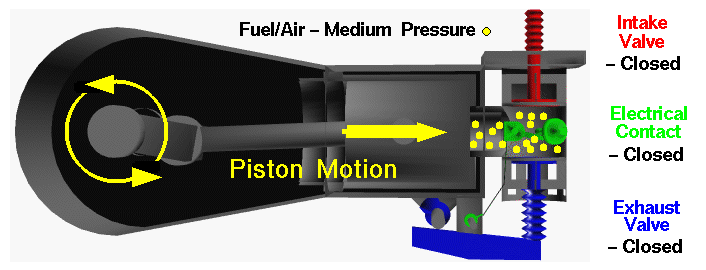
During the compression, no heat is transferred to the
fuel/air mixture. As the volume is decreased because of the piston's motion, the
pressure in the gas is increased, as described by the
laws of thermodynamics. In the figure, the mixture has
been colored yellow to denote a moderate increase in pressure. To produce the
increased pressure, we have to do work on the mixture,
just as you have to do work to inflate a bicycle tire using a pump. During the
compression stroke, the electrical contact is kept opened. When the volume is
the smallest, and the pressure the highest as shown in the figure, the contact
is closed, and a current of electricity flows through the plug.
Power Stroke
At the beginning of the power stroke, the electrical contact is opened. The
sudden opening of the contact produces a spark in the combustion chamber which
ignites the fuel/air mixture. Rapid combustion of the
fuel releases heat, and produces exhaust gases in the
combustion chamber.
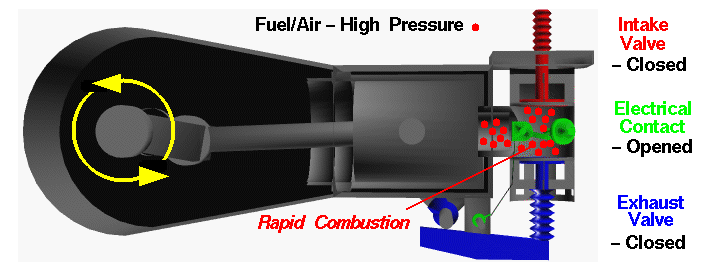
Because the intake and exhaust valves are closed, the combustion of the fuel
takes place in a totally enclosed (and nearly constant volume) vessel. The
combustion increases the temperature of the exhaust
gases, any residual air in the combustion chamber, and the combustion chamber
itself. From the ideal gas law, the increased
temperature of the gases also produces an increased pressure in the combustion
chamber. We have colored the gases red in the figure to denote the high
pressure. The high pressure of the gases acting on the face of the piston cause
the piston to move to the left which initiates the power
stroke.
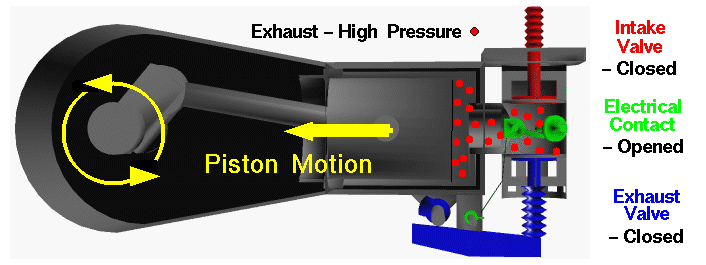
Unlike the compression stroke, the hot gas does work on the piston during the
power stroke. The force on the piston is transmitted by the piston rod to the
crankshaft, where the linear motion of the piston is converted to angular motion
of the crankshaft. The work done on the piston is then used to turn the shaft,
and the propellers, and to compress the gases in the neighboring cylinder's
compression stroke. Having produced the igniting spark, the electrical contact
remains opened.
During the power stroke, the volume occupied by the gases is increased
because of the piston motion and no heat is transferred
to the fuel/air mixture. As the volume is increased because of the piston's
motion, the pressure and temperature of the gas are decreased. We have colored the exhaust "molecules"
yellow to denote a moderate amount of pressure at the end of the power stroke.
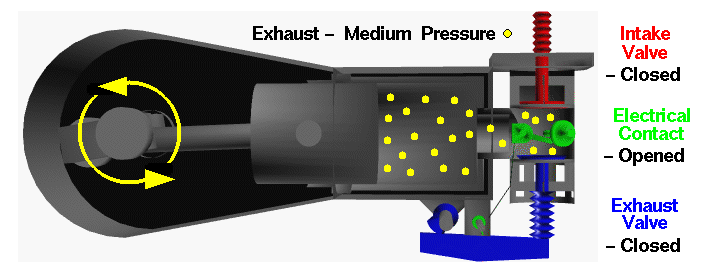
Historical note - The method of producing the electrical spark used
by the Wright brothers is called a "make and break" connection. There are moving
parts located inside the combustion chamber. Modern internal combustion engines
do not use this method, but instead use a spark plug to produce the ignition
spark. A spark plug has no moving parts, which is much safer than the method
used by the brothers.
Exhaust Stroke
At the end of the power stroke, the piston is located at the far left. Heat
that is left over from the power stroke is now transferred to the water in the water jacket until the pressure approaches atmospheric
pressure. The exhaust valve is then opened by the cam pushing on the rocker arm
to begin the exhaust stroke.
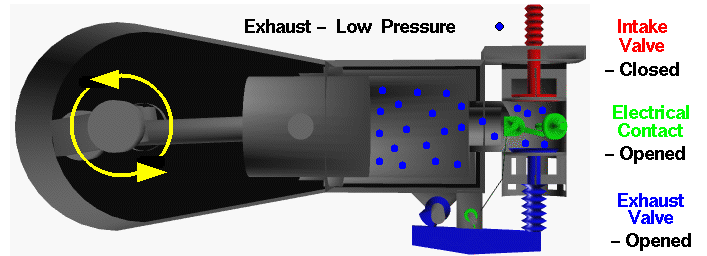
The purpose of the exhaust stroke is to clear the cylinder of the spent
exhaust in preparation for another ignition cycle. As the exhaust stroke begins,
the cylinder and combustion chamber are full of exhaust products at low pressure
(colored blue on the figure above.) Because the exhaust valve is open, the
exhaust gas is pushed past the valve and exits the engine. The intake valve is
closed and the electrical contact is open during this movement of the piston.
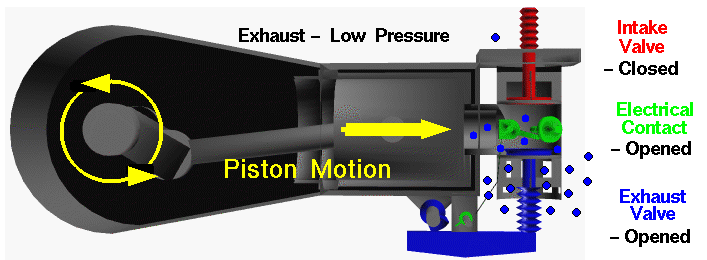
At the end of the exhaust stroke, the exhaust valve is closed and the engine
begins another intake stroke.
Historical note - The exhaust system used by the Wright brothers
caused the hot exhaust to exit each cylinder independently ... right next to the
pilot. This engine was very loud as well. Modern automobiles collect the exhaust
from all of the cylinders into an exhaust manifold (just like the intake
manifold used by the brothers). The exhaust manifold passes the exhaust to the
catalytic converter to remove dangerous gases, and then through the muffler to
keep it quiet, and finally out the exhaust pipe.
You should now be able to make some sense from the animation at the top of
this page. Notice that the crankshaft makes two revolutions for every one
revolution of the cams. This motion is controlled by the timing chain. Also notice how the cam moves the exhaust
valve at just the right time and how quickly the intake valve opens after the
exhaust valve is closed. In real engine operation, the exhaust stroke can not
push all of the exhaust out of the cylinder, so a real engine doesn't perform as
well as the ideal engine described on this page. As the engine runs and heats
up, the performance changes. Modern automobile engines adjust the fuel/air ratio
with computer controlled fuel injectors to maintain high performance. The
brothers just had to watch the horsepower of their engine drop from about 16
horsepower when the engine was first started to about 12 horsepower when it was
running hot.












0 Comments:
Post a Comment
Subscribe to Post Comments [Atom]
<< Home